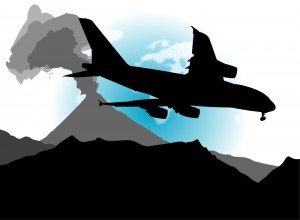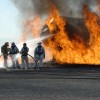Ash Clouds
[audio:https://aviationenglishblog.com/wp-content/uploads/2010/08/14ashclouds.mp3|titles=Ash Clouds]TOPIC: Ash Clouds
GOAL: To learn about ash cloud’s effect on traffic and how to deal with an encounter.
Level: Medium
Exercise #1: Read about the dangers of flying through ash clouds and how to handle such a situation.
In April 2010, Europe's skies remained largely closed for several days after a mass of volcanic ash which originated from Iceland blanketed the continent causing crippling flight delays. Due to the disruptions to air traffic, a major portion of 22,000 scheduled flights destined to take off from locations throughout Europe were cancelled. In fact, only 6,000 departed during the near weeklong event. The International Air Transport Association estimated the air traffic interruptions caused approximately $200 million in damage a day. Contrary to popular belief, flying through ash will not completely destroy an aircraft in seconds, but the abrasive particles will certainly cause great exterior and electrical damage to airplanes flying through the clouds over a very short period time.
 One thing is to cancel a flight when the presence of ash is found when the weather forecast calls for such phenomenon. The other is to fly right through this type of obscuration. So, the obvious question is: How do you handle such an in-flight scenario? In 1999, Boeing Commercial Airplanes published an article in Aero, the company's technical journal, about encountering volcanic ash clouds. If you should find yourself inside a volcanic ash cloud, Boeing recommends taking nine steps to getting yourself, your crew and your passengers out of harm’s way.
One thing is to cancel a flight when the presence of ash is found when the weather forecast calls for such phenomenon. The other is to fly right through this type of obscuration. So, the obvious question is: How do you handle such an in-flight scenario? In 1999, Boeing Commercial Airplanes published an article in Aero, the company's technical journal, about encountering volcanic ash clouds. If you should find yourself inside a volcanic ash cloud, Boeing recommends taking nine steps to getting yourself, your crew and your passengers out of harm’s way.
The following nine procedures are general recommendations. Each operator's flight operations manuals will include more specific directions.
1. Reduce thrust to idle immediately. By reducing thrust, engines may suffer less buildup of molten debris on turbine blades and hot-section components. Idle thrust allows engines to continue producing electrical power, bleed air for pressurization, and hydraulic power for airplane control.
2. Turn the autothrottles off. This prevents the engines from increasing thrust above idle. Ash debris in the engine can result in reduced surge margins, and limiting the number of thrust adjustments improves the chances of engine recovery.
3. Exit the ash cloud as quickly as possible. A 180-deg turn out of the ash cloud using a descending turn is the quickest exit strategy. Many ash clouds extend for hundreds of miles, so assuming that the encounter will end shortly can be false. Climbing out of the ash could result in increased engine debris buildup as the result of increased temperatures. The increased engine buildup can cause total thrust loss.
4. Turn on engine and wing ice protection system and all air-conditioning packs. These actions improve the engine stall margins by increasing the flow of bleed air.
5. If possible, start the auxiliary power unit auxiliary power unit (APU). The APU can power systems in the event of a multiple-engine power loss. It can also be used to restart engines through the use of APU bleed air.
6. If volcanic dust fills the flight deck, the crew may need to use oxygen. Use flight deck oxygen at the 100 percent setting. Manual deployment of the passenger oxygen system is not required because it will deploy automatically if the cabin altitude exceeds 14,000 ft.
7. Turn on the continuous ignition. Confirm that autostart is on, if available. In the event that the engines flame out or stall, use appropriate procedures to restart the engines. During restart, the engines may take longer than normal to reach idle thrust due to the combined effects of high altitude and volcanic ash ingestion. If an engine fails to start, try restarting it again immediately. Flight crews should remember that the airplane may be out of the airstart envelope if the encounter occurs during cruise.
8. Monitor exhaust gas temperature gauge(EGT). Because of potential engine debris buildup, the EGT can climb excessively. The flight crew should prevent EGT exceeding its operational limits. Shut down the engine and restart it if the EGT is approaching limits similar to a hung start.
9. Fly the airplane by monitoring airspeed and pitch attitude. If necessary, follow the procedure for flight with unreliable airspeed.
Exercise #2: Hear audio/watch video:
- This is part of an audio interview with Capt. Eric Moody, the Captain of British Airways Flight 9 which suffered a four engine failure over Indonesia in June 1982 after flying in to the ash cloud from the erupting Mt. Galungung. He discusses the effects of this encounter and how the crew responded.
- This CBS News video report provides us with a look at the 2010 Icelandic volcanic eruption and what effects it had on the airline industry at the time.
Exercise #3: Answer the following questions, which are based on the information contained in the text and audio/video you’ve just studied.
- True or False: An airplane that flies into a volcanic ash cloud will explode in seconds.
- True
- False
Answer = b
- What components of an aircraft will likely be affected by volcanic ash?
- engines
- lights
- windscreen
- All of the above
Answer = d
- Which of the following is Boeing’s recommendation for exiting an ash cloud?
- A 180-degree descending turn
- A 180-degree ascending turn
- A 90-degree descending turn
- A 90-degree ascending turn
Answer = a
- Approximately how many flights were affected by the Icelandic volcano eruption in 2010?
- 100,000
- 50,000
- 200,000
- 22,000
Answer = d
- According to the interview with Capt. Eric Moody, how long did British Airways Flight 9 glide without any engine power?
- 40 minutes
- 14-15 minutes
- 1 hour
- 55 minutes.
Answer = a

















Recent Comments